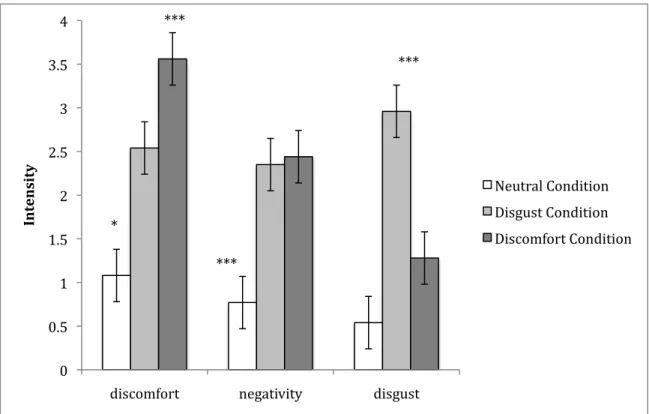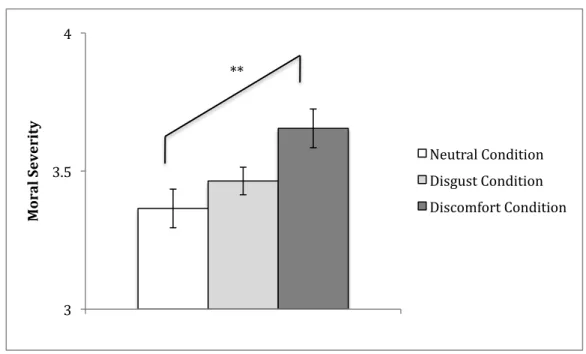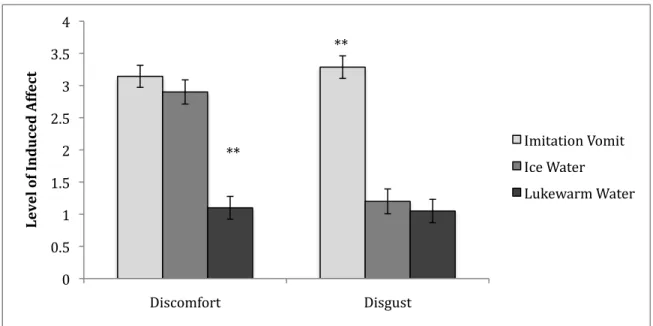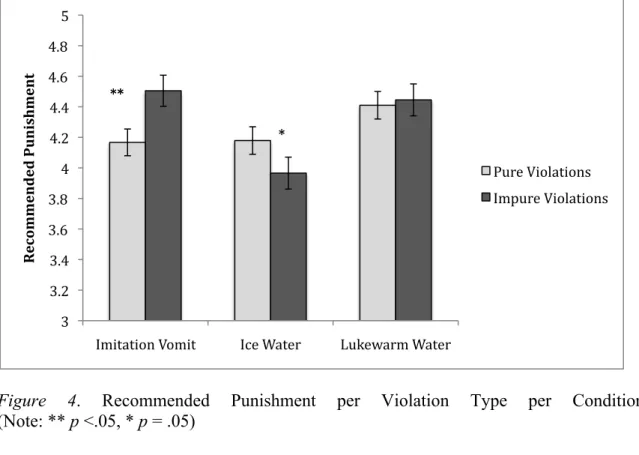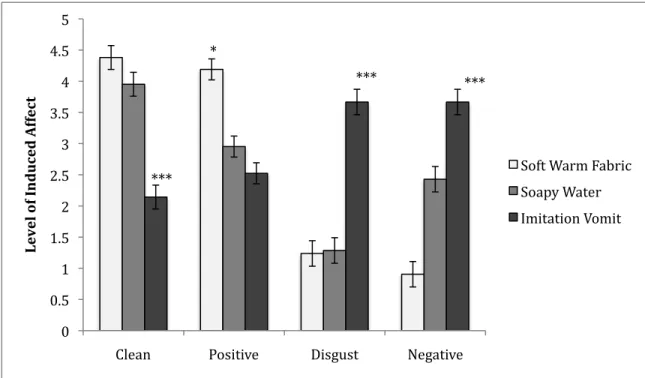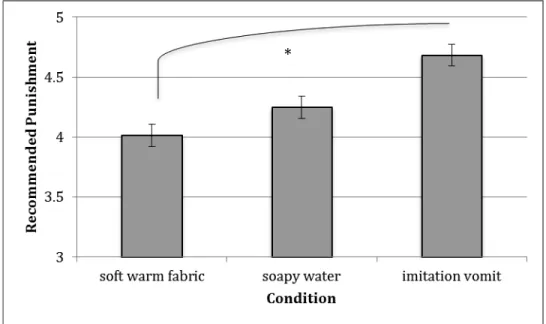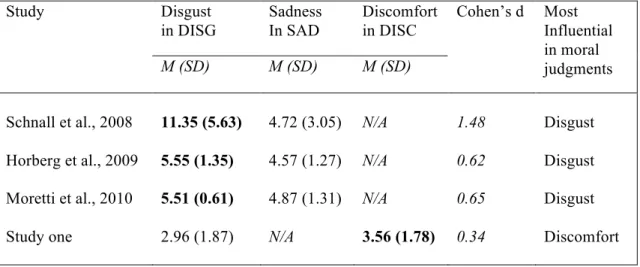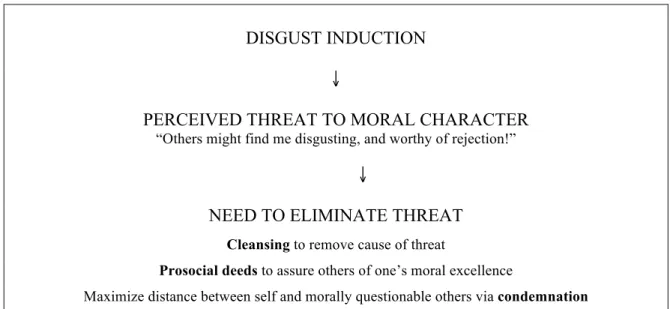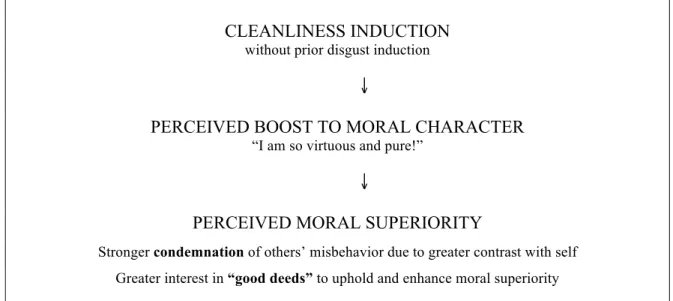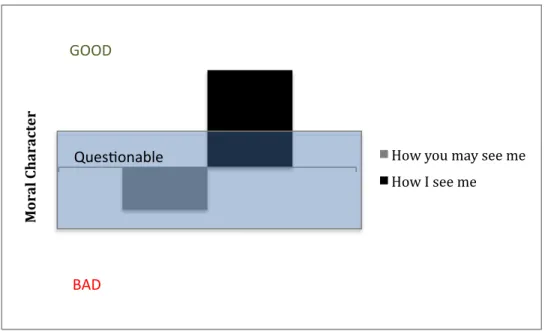THE INFLUENCE OF DISGUST ON JUDGMENTS ABOUT MORAL VIOLATIONS
By Bea David
Dissertation
Submitted to the Faculty of the Graduate School of Vanderbilt University
In partial fulfillment of the requirements for the degree of
DOCTOR OF PHILOSOPHY in
Psychology
August, 2012 Nashville, Tennessee
Approved by:
Dr. Bunmi Olatunji, Chair Dr. Craig Smith Dr. F. Joseph McLaughlin
Dr. Owen Jones
ACKNOWLEDGEMENTS
I want to start by thanking my academic advisor and chair of my dissertation committee, Dr. Bunmi Olatunji, for all his support in my development as a critical thinker, experimenter, and writer. This dissertation would not have been possible without his willingness to listen and provide feedback. His pointed questions, often challenging, helped further my conceptualizations and consistently improved the quality of my work.
Like nobody else, he was interested in the details of my research and writing, and I am grateful for his constant availability as a mentor throughout this dissertation project and my graduate career more broadly. He taught me how to be a scientist.
The members of my committee are invaluable in the creation of this dissertation as well, as they have guided and supported me through my major area paper, dissertation proposal, and now the dissertation. Dr. Craig Smith, with whom I initially started my graduate training, taught me the importance of letting ideas grow over time and paying attention to the details of studies and theories. His teachings regarding model development contributed to my motivation to develop a model myself. Dr. F. Joseph McLaughlin has consistently supported my career development, both as a researcher and a clinician, and has encouraged me through the successes and challenges of graduate school. His positive outlook on life has been an inspiration to me. Dr. Owen Jones has provided excellent feedback and raised important questions to improve my research. His support for a grant application, as well as the materials and information he provided from his area of expertise (i.e., Law) have been tremendously helpful.
I have been fortunate to work with and mentor various undergraduate students, learning from them and with them. Thank you Andrew Youssef, Lydia Qualls, Lindsay Kramer, Emily Abernathy, Amanda Izquierdo, and Valerie Aguilar. These students collected the majority of the data and offered excellent observations as well as interesting ideas throughout this research project. In addition, this research would not have been possible without the practical and mental support and flexibility of the entire Emotion and Anxiety Research Lab. I want to specifically thank Tom Armstrong for being a major source of support through graduate school, and for his friendship. I am also particularly grateful toward Mimi Zhao, our lab manager, whose reliable nature and willingness to help contributed greatly to the successful completion of this research project.
I could not have completed this dissertation without the never-ending support and encouragement from my friends and family. I want to thank my close friends for providing meaningful, enjoyable and relaxing experiences that allowed me to better balance my personal and professional life. My parents have been an ongoing source of motivation to me, and I want to thank them specifically for their willingness to have their daughter live in another continent to pursue her career goals. Finally, I want to thank my husband, Micah, whose love for and belief in me, as well as his understanding, humor, and thoughtful efforts toward me have offered that extra encouragement when I needed it the most.
TABLE OF CONTENTS
Page
ACKNOWLEDGEMENTS... ii
LIST OF TABLES... vi
LIST OF FIGURES ... vii
Chapter I. INTRODUCTION ...1
The Morality of Disgust...3
II. LIMITATIONS OF THE EXISTING RESEARCH...8
III. STUDY ONE. THE ROLE OF DISGUST AND DISCOMFORT IN MORAL JUDGMENT: COMPARING TWO NEGATIVE EMOTIONS ASSOCIATED WITH CERTAINTY, IN A ONE-PHASE PARADIGM...12
Method ...12
Results...15
Discussion ...20
IV. STUDY TWO. DISGUST, DISCOMFORT AND MORAL VIOLATIONS: EXAMINING THE INTENSITY HYPOTHESIS FOR PURITY AND NON-PURITY VIOLATIONS...22
Method ...24
Results...26
Discussion ...31
V. STUDY THREE. FUNCTIONAL OPPOSITES BUT CONCEPTUAL EQUALS? HOW FEELING CLEAN AND DISGUSTING AFFECT JUDGMENTS ABOUT MORAL VIOLATIONS ...34
Method ...37
Results...38
Discussion ...46
VI. GENERAL DISCUSSION ...48
Limitations ...62
Implications...64
Conclusions...69
Appendix A. MORAL VIOLATIONS STUDY ONE ...70
B. MORAL VIOLATIONS STUDY TWO AND THREE ...71
C. QUESTIONNAIRES USED IN STUDY ONE, TWO, AND THREE...72
REFERENCES ...74
LIST OF TABLES
Table Page
1. Means and Standard Deviations of Reported Disgust, Sadness, and Discomfort in Respective Conditions, and Emotion of Most
Influence on Moral Judgments...50
LIST OF FIGURES
Figure Page
1. Disgust, Negativity and Discomfort ratings in the Disgust,
Negative and Neutral condition ...16
2. Morality Ratings across Levels of Moral Offense...18
3. Ratings of Discomfort and Disgust per Condition...28
4. Recommended Punishment per Violation Type per Condition ...29
5. Cleanliness, Positivity, Disgust and Negativity ratings per condition ...41
6. Recommended Punishment per Condition...42
7. Threatened Moral Character after Disgust Induction ...54
8. Superiority associated with Cleanliness in a Moral Character Model...57
9. Attention to Moral Character for High DS Individuals ...59
10. Moral Character as Perceived by Self and Others after Disgust Induction ...59
11. Moral Character as Perceived by Self and Others for Those High in Self-Disgust ...60
CHAPTER I
INTRODUCTION
Imagine the following moral offenses: Fred urinated on a car door handle, Kim stole from the collection plate at church, Peter left his grandmother waiting at the hospital for three hours, and Jennifer spray-painted on someone’s favorite jacket. When reading these moral transgressions, various thoughts and feelings are inevitably elicited, which may help determine how wrong these violations are and how much punishment is deserved. Traditionally, moral decisions were believed to result from careful conscious considerations of the expected harm or utility of a transgression (i.e., consequentialist model; e.g., Bentham, 1781/1988) or the intentions of the transgressor (i.e., deontological model; e.g., Kant, 1986/1785). Such considerations, according to deontological or consequential models, ought to cause emotions, secondary to conscious reasoning. Until recently, moral judgment about another person’s actions was thought to result from conscious, deliberate considerations regarding relevant moral principles such as fairness, care, and respect, as well as intentionality of the actors and severity of the actions (e.g., Kant, 1986; Kohlberg, 1984). However, people often reach moral judgments outside of conscious awareness, challenging the central role of reasoning in moral decision-making.
Evidence that reasoning may not be central in moral decision-making comes from research showing that moral judgments occur automatically (Lou et al., 2006) and when cognitive resources are unavailable (Greene, Morelli, Lowenberg, Nystrom, Cohen, 2008). People often reach strong moral judgments without being able to explain why
they made such judgments (i.e., “moral dumbfounding”; Cushman, Young, & Hauser, 2006; Haidt, Bjorklund, & Murphy, 2000), and even preverbal (pre-reasoning) children, as young as 6 months old, have been found to make moral judgments (Hamlin, Wynn, &
Bloom, 2007). These findings suggest that conscious reasoning is not required for attaining moral judgments and that other factors may be more influential in this process.
Consistent with this thinking, the Social Intuitionist Model (Haidt, 2007) posits that exposure to moral transgressions elicits an automatic “flash” of moral intuitions, or basic good-bad evaluations of the transgression or transgressors. These flashes are thought to result in immediate moral judgments, without going through careful deliberations of right and wrong (although reasoning can at times alter moral intuitions secondarily). However, the extent to which careful reasoning or automated affect is employed may be context dependent. For example, the Dual-Process Theory (Greene, 2007) proposes that the degree to which emotions versus reasoning cause moral decisions depends on the transgression itself. If the transgression is up-close and personal, people are more likely to base their moral judgment on emotions than if the transgression is impersonal.
Emotions (Haidt, 2001; Haidt & Kesebir, 2010) have been proposed as primary determinants of moral judgment, and the notion of “affective primacy”, where an immediate good-bad evaluation of a person or action is thought to determine moral judgment (Haidt, 2007), has received support from various sources. While the influence of emotions can at times be altered via conscious reasoning (Haidt, 2001), emotions are thought to be elicited prior to reasoning and therefore hypothesized to have a greater influence on moral judgments than reasoning (Schnall, Haidt, Clore, & Jordan, 2008).
This association between morality and emotions has been demonstrated in neuroscience
research, where moral behavior (e.g., acting fairly) was found in association with emotion-related brain activity in the orbito-frontal cortex (OFC) and the anterior insula (Rilling et al., 2007; Sanfey, Rilling, Aronson, Nystrom, & Cohen, 2003). Also, individuals with impairments in brain structures thought to be necessary to integrate emotions into decision-making (e.g., patients with ventro-medial prefrontal cortex (VMPFC) damage; psychopaths) have shown difficulties reaching typical moral judgments (Blair, 2007; Koenigs et al., 2007). Indeed, while most individuals consider utilitarian judgments appropriate when the situation is impersonal (e.g., pulling a lever to direct a train away from a track with four workers to a track with one worker) but not when it is personal and close (e.g., pushing someone onto a train track to stop a train and keep it from killing four workers), judgments of patients with damage to the VMPFC and psychopaths are unaffected by emotion and are utilitarian in both cases. These findings suggest that emotions play a crucial role in informing, and potentially causing, moral decisions. Although the majority of the evidence for this notion has focused on the primacy of elementary good-bad evaluations, researchers have begun to examine the role of specific emotions in moral decision-making.
The Morality of Disgust
Disgust is considered particularly informative in guiding moral decision-making (e.g., Rozin, Haidt, & McCauley, 2000) and has recently received much attention in the research literature (e.g., Horberg, Oveis, Keltner, & Cohen, 2009; Moretti & di Pellegrino, 2010; Schnall, Haidt, et al., 2008; Wheatley & Haidt, 2005). Although disgust is traditionally viewed as a disease avoidance mechanism aimed at preventing
oral incorporation of contaminated substances (Oaten, Stevenson, & Case, 2009), it is also thought to regulate moral behavior (e.g., Looy, 2004; Miller, 1997; Schnall, Haidt, et al., 2008) and functions as an immorality-avoidance mechanism by signaling that objects, behaviors, or persons are to be avoided in order to maintain “purity.” Labeling a behavior as “disgusting” typically leads to a reduction in its occurrence (e.g., smoking;
Rozin & Singh, 1999) as people work hard to prevent being considered disgusting, and risk being rejected from their ingroup (Kahan, 1998).
People who are prone to experiencing disgust (i.e., people high in disgust sensitivity, DS; Haidt, McCauley, & Rozin, 1994), tend to make more severe moral judgments and this effect has been observed in response to homosexuality (Inbar, Pizarro, Knobe, & Bloom, 2009; Olatunji, 2008), the use of animals in research (Herzog &
Golden, 2009), criminal offenses (Jones & Fitness, 2008) and violations of purity (Horberg et al., 2009). The mechanism(s) by which a proneness to experience disgust may affect moral judgments however, remain unclear. Those prone to experience disgust (i.e., high in DS) experience this emotion more frequently and intensely, which may render disgust the primary emotion available when these individuals are asked to judge a moral offense. According to the affect-as-information model (Schwarz & Clore, 1983) people often determine what they think about a given situation by asking themselves how they feel about it. With disgust being available more readily, high DS individuals may consider this emotion as relevant to moral violations (“I feel disgusted, so this situation must be bad!”), resulting in more severe moral judgments. It is noteworthy that this feeling of disgust can influence judgments whether it is caused by the situation to be judged (Haidt, et al., 2000) (e.g., “Hearing about a brother and sister having sex makes
me feel disgusted”) or by other disgust cues that may be irrelevant to the violation (Schnall, Haidt, et al., 2008) (e.g., unpleasant smell in the room, facial malformation of transgressor).
High DS individuals are also more “morally hypervigilant” than those low in DS (Jones & Fitness, 2008), and are thus more actively looking for signs of moral deviance.
It is well documented that disgust functions to protect from contamination (e.g., Rozin, et al., 2000). Accordingly, feelings of disgust may motivate detection and avoidance of various sources of contamination, including those moral in nature. Indeed, evolutionary theory suggests that moral disgust motivates avoidance of relationships with moral norm violators due to their costly nature (e.g., being betrayed, harmed, stolen from) (Tyber, Lieberman, & Griskevicius, 2009). A recent study found that trait disgust predicted recommended punishment of purity violations (e.g., keeping a dirty living space) as well as reward of virtues (e.g., meditating), implicating the unique role of disgust in moral judgments regarding purity (Horberg et al., 2009). Under conditions of ambiguity (e.g., uncertain culpability) those high in DS tend to assume guilt of suspects and recommend harsh punishments (Jones & Fitness, 2008) to maximize distance between themselves and potential moral offenders, thereby minimizing the risk of contact. DS may thus be associated with harsher moral judgments because these individuals’ threshold for detecting immorality is lower.
The available correlational evidence demonstrates a significant association between disgust and morality (e.g., Rozin, Markwith, & Stoess, 1997; Rozin & Singh, 1999; Stein & Nemeroff, 1995). However, causal claims about the role of disgust in moral judgment require experimental manipulation of disgust induction and its influence
on moral decision-making. To date, a few such studies have been conducted. For example, Wheatley and Haidt (2005) induced disgust in participants by first teaching them to feel disgusted upon exposure to a given (neutral) word, via hypnosis, and later embedding this word in descriptions of moral transgressions. Participants found transgressions containing this word more disgusting and more morally wrong than transgressions that did not contain this word. In a subsequent study, Schnall, Haidt and colleagues (2008) induced disgust via an unpleasant odor, a movie clip, a dirty work environment, or a writing task, and found that, for those sensitive to internal sensations (i.e., those with high private body consciousness; Miller, Murphy, & Buss, 1981), induced disgust, compared to neutral affect, led to more severe judgments of morally- relevant behaviors (Schnall, Haidt, et al., 2008). Lastly Eskine and colleagues (2011) recently found that a bitter and disgusting taste in participants’ mouth resulted in more severe moral judgments than a sweet or neutral taste (Eskine, Kacinik, and Prinz, 2011).
The few available experimental findings provide initial support for the view that experiencing disgust results in more severe moral judgment. However, a major conceptual limitation of these studies, comparing disgust induction to neutral affect induction, is that they leave open the possibility that the documented influence of disgust on moral judgments is mainly one of negative affect, not the emotion of disgust specifically. In response to such concerns, three recent studies have compared disgust with sadness, and some support for the specificity of disgust in moral judgments has been observed. For example, Schnall, Haidt and colleagues (2008) found that disgust priming via a movie clip, led to more severe moral judgments than did sadness priming for participants sensitive to internal bodily sensations. Similarly, Horberg and colleagues
(2009) found that participants who had been primed with disgust via a movie clip, compared to those primed with a sadness clip, reported more perceived moral wrongness and rightness of purity violations (e.g., being sexually promiscuous) and virtues (e.g., maintaining a healthy body), respectively. In a recent study by Moretti and di Pellegrino (2010) participants were primed with disgust, sadness, or neutral affect (via exposure to images) prior to participation in an Ultimatum Game. People responded more strongly to unfairness in the Ultimatum Game after disgust priming than after sadness or neutral affect priming. From these findings, the authors concluded that disgust is indeed uniquely associated with morality and distinct from other emotions in its influence on morally relevant decision-making.
CHAPTER II
LIMITATIONS OF THE EXISTING RESEARCH
Although important advances have been made in the literature delineating the unique role of disgust in moral judgments (e.g., Horberg et al., 2009; Moretti & di Pellegrino, 2010; Schnall, Haidt, et al., 2008), several limitations of this line of research need to be addressed and alternative interpretations of the existing data considered. First, the observed greater moral severity following disgust induction (compared to neutral affect induction), but not following sadness induction (Horberg et al., 2009; Moretti & di Pellegrino, 2010; Schnall, Haidt, et al., 2008) may be caused by characteristics of disgust and sadness that are irrelevant to making moral judgments. Disgust has been identified as a “sticky” emotion (Olatunji, Forsyth, & Cherian, 2007), more resistant to extinction than other emotions. This feature of disgust may render it particularly influential in paradigms where emotions are induced first (phase one), and their influence on moral judgments is measured later (phase two). Sadness, as a comparison emotion, may have failed to affect moral judgments in prior research (Horberg et al., 2009; Moretti & di Pellegrino, 2010) because it dissipated before participants actually made moral judgments. The dissipation disparity between more sticky disgust and the potentially more quickly extinguished sadness may explain the uniquely influence of disgust on judgments about moral violations.
Alternatively, sadness and disgust may dissipate at an equal rate, but sadness may influence moral judgments less so than disgust due to their differential certainty
appraisals (i.e., sense of certainty about what is happening and what will happen next;
Smith & Ellsworth, 1985). This difference may explain why disgust is more likely to affect any judgments, but not moral judgment specifically. While disgust is characterized by a sense of certainty about the situation and what will happen next (Tiedens & Linton, 2001), sadness is more closely associated with uncertainty (Smith & Ellsworth, 1985).
Feeling certain is thought to indicate accuracy of one’s beliefs and judgments, and may limit the need for further, more careful deliberation of a situation (Mackie & Worth, 1989). Certainty appraisals have been found to increase reliance on heuristics (i.e., quick rules of thumb, stereotypes, emotions) (e.g., Lerner, Goldberg, & Tetlock, 1998; Tiedens
& Linton, 2001), especially when the situation bears little personal relevance, or the person judging it has little motivation to engage in careful processing or to reach a specific conclusion (Forgas, 1995; Tetlock, 1985).
The moral judgments made in most published studies typically have low personal relevance, and no experimental manipulations to encourage careful processing (e.g., accountability manipulations, Lerner et al., 1998) are employed, allowing a greater influence of disgust and its associated sense of certainty. Careful, deliberate and systematic processing of situations to be judged has been found to reduce the influence of extraneous emotions, stereotypes, or other heuristics in decision-making (Bodenhausen, Gabriel, & Lineberger, 2000). Emotions that trigger this type of processing (e.g., sadness, hope; Smith & Ellsworth, 1985) may be especially unlikely to influence judgments, in particular when these emotions are unrelated to the situation to be judged.
Disgust may thus influence moral judgments more strongly than sadness due to the difference in certainty appraisals associated with each emotion. Accordingly, it may be
premature to conclude that disgust is uniquely predictive of moral judgments as other negative emotions that are characterized by certainty appraisals and associated systematic processing tendencies may play a similar role (Tiedens & Linton, 2001).
By comparing disgust with other negative emotions, more specific claims about its unique role in moral judgments can be made. Affect elicited during hand submersion in ice water may be an opportune comparison to disgust in the context of making moral judgments. Hand submersion in ice water, also known as the “cold pressor task”, has been widely used as a method to examine how pain and discomfort influence cognitive processes such as judgment, punishment (Berkowitz, 1993), and attention (Eccleston &
Crombez, 1999). Prior research suggests that pain demands attention and thereby interrupts deliberate cognitive processes (Eccleston & Crombez, 1999). Such interruption of normal cognitive processing is typically associated with increased reliance on heuristics and affect-driven, automatic processing (Greene et al., 2008). Inducing discomfort may therefore be a well-suited comparison affect to examine the unique role of disgust on moral judgments. Although discomfort is not a basic emotion (e.g., disgust or sadness), it consists of sensory and affective components (Price, 2000). Furthermore, discomfort is negative in its experienced valence, making it appropriate to compare to disgust in relation to influencing moral judgments.
The first study of this investigation aimed to explore whether disgust is uniquely informative of moral judgments by comparing the influence of disgust on moral judgments to that of discomfort. To eliminate possible dissipation disparity as an explanation for differences between disgust and discomfort, moral judgments where made during the affect induction (i.e., in a one-phase paradigm). Consistent with prior
research indicating a unique role for disgust in moral decision-making, it was predicted that ratings of immorality regarding moral transgressions would be higher during disgust induction than during discomfort induction and a neutral affect control condition.
However, if the increased severity of moral judgments associated with disgust is an artifact of the negative valence associated with disgust, then ratings of immorality in the discomfort and disgust condition are expected to be significantly higher than those in the neutral condition, but not differ significantly from one another.
CHAPTER III
STUDY ONE. THE ROLE OF DISGUST AND DISCOMFORT IN MORAL JUDGMENT: COMPARING TWO NEGATIVE EMOTIONS ASSOCIATED WITH
CERTAINTY, IN A ONE-PHASE PARADIGM
Method
Participants
Seventy-seven undergraduate students (N = 77, 82% female, 69% Caucasian) participated in exchange for course credit.
Materials
Moral Transgressions. Twelve one-sentence descriptions of three levels of moral transgression (non-offenses, moderate offenses, severe offenses) were presented to participants in random order (See Appendix A). Non-offenses (N = 4) described behavior that is not morally wrong (e.g., F.W. went for a walk in the park). Moderate offenses (N = 4) described behavior that is morally questionable, but not extremely immoral (e.g., K. D. lied to a good friend). Severe offenses (N = 4) described extreme wrongdoings (e.g., G.S. murdered two people in their own home). These 12 offenses were selected from a larger pool of offenses on the basis of pilot data.
Affect Induction. Affect was induced via submersion of the participants’ left hand, in a thin plastic glove, into one of three liquids (imitation vomit, ice water, or lukewarm water, depending on the condition they were randomly assigned to) while
rating each of the 12 moral transgressions. The imitation vomit in the disgust condition consisted of cream of mushroom soup, cream of chicken soup, black beans, and chopped- up pieces of fried gluten. This recipe was partially based on a recipe for imitation vomit developed by Tsao and McKay (2004). The ice water in the discomfort condition measured 50 degrees, and this temperature was kept constant by adding ice cubes to the water throughout the experiment. Finally, participants in the neutral condition were asked to place their hand in lukewarm water (80 degrees). All liquids were kept in white, four-gallon containers.
Ratings. Participants were asked to rate how morally wrong they found each transgression on a scale from 0 (not morally wrong at all) to 7 (extremely morally wrong). They were also asked to indicate how disgusting they found each of the transgressions, on a scale from 0 (not at all disgusting) to 7 (extremely disgusting).
Finally, participants were asked to rate how much punishment they thought each transgression deserved on a scale from 0 (not at all deserving of punishment) to 7 (extremely deserving of punishment).
Questionnaires. The Disgust Sensitivity Scale-Revised (DS-R; Haidt et al., 1994, modified by Olatunji, Williams, et al., 2007) is a 25-item scale that measures disgust sensitivity across domains of core, animal reminder, and contamination disgust.
Participants are asked to indicate to what extent they agree with statements like “It bothers me to hear someone clear a throat full of mucous” on a 5-point scale, ranging from 0 (strongly disagree) to 4 (strongly agree), and they are also asked to indicate how disgusting they find things such as “You see a man with his intestines exposed after an
accident” on a 5-point scale ranging from 0 (not disgusting at all) to 4 (extremely disgusting). The DS-R had an alpha coefficient of .84 in the present study.
For the Negative Affect component (alpha = .80) of the Positive and Negative Affectivity Scale (PANAS, Watson, Clark, & Tellegen, 1988) participants are asked to indicate how they typically feel, in terms of 10 negative (e.g., “hostile”) emotions, and they rate these items on a 5-point Likert scale, ranging from 1 (very slightly or not at all) to 5 (extremely).
Procedure
After completing the DS-R and the NA of the PANAS, participants were randomized to one of three affect inductions. In the disgust condition, participants placed their hand in a glove and then in a container filled with imitation vomit. Participants were asked to hold their hand in the vomit while making their ratings of disgust, immorality and punishment for each moral transgression. After rating a given transgression, participants removed the glove from their hand, discarded it, and put on a new glove, to prevent habituation. In the discomfort condition, participants placed their hand in a glove and then in a container filled with ice water, while making their ratings.
Immediately following completion of the ratings for a given transgression, participants placed their hand in a container with lukewarm water (80 degrees) for two minutes, to raise their hand temperature, before submerging it in ice water again to rate the next transgression. In the neutral condition, participants placed their hand in a glove, and then in lukewarm water, while rating the moral transgressions. After rating a given
transgression, participants removed the glove from their hand, discarded it, and put on a new glove.
For all participants, the time between finishing ratings for one transgression and starting ratings for the next transgression was two minutes. This time allowed for raising hand temperature (in the discomfort condition) and helped prevent carry-over effects from one transgression to the next. After all 12 transgressions were rated, participants indicated how negative and disgusted their task (submerging the hand in liquid) made them feel, as well as how much discomfort they experienced during this task on a scale from 0 (not at all) to 7 (extremely).
Results
Affect Induction Manipulation Check
A 3 (condition: disgust, discomfort, neutral) X 3 (emotion rating: disgust, negativity, discomfort) mixed-factor ANOVA yielded significant main effects of condition [F(2, 74) = 14.34, p < .001] and emotion rating [F(2, 148) = 13.31, p < .001].
These main effects were qualified by a significant condition by emotion rating [F(2, 148)
= 12.90, p < .001] interaction. Disgust, discomfort and negativity ratings were then entered in a multivariate ANOVA with condition as the independent variable, revealing a main effect of condition for disgust [F(2, 74) = 17.58, p < .001], discomfort [F(2, 74) = 16.69, p < .001] and negativity [F(2, 74) = 8.47, p < .001]. Pairwise follow-up comparisons of the conditions (disgust, discomfort, neutral) for disgust, negativity and discomfort revealed that, as predicted, participants reported significantly more disgust in
the disgust condition (M = 2.96 SD = 1.87) than in the discomfort condition (M = 1.28, SD = 1.60, p < .001) or in the neutral condition (M = 0.54, SD = .91, p < .001), and the latter two did not significantly differ (see Figure 1). Furthermore, participants reported significantly more discomfort in the discomfort condition (M = 3.56, SD = 1.78) than in the disgust condition (M = 2.54, SD = 1.77, p < .001) and in the neutral condition (M = 1.08, SD = .94, p < .001). They also reported more discomfort in the disgust than in the neutral condition (p = .021). Negativity did not differ in the disgust and discomfort conditions (see Figure 1) while participants reported more negativity in the disgust (M = 2.35 SD = 1.70) and discomfort (M = 2.44, SD = 1.92) conditions than in the neutral condition (M = 0.77, SD = 1.24, pdisgust-neutral < .001, pnegative-neutral < .001).
Figure 1. Disgust, Negativity and Discomfort ratings in the Disgust, Negative and Neutral condition (Note: *** p < .001, * p < .05)
0 0.5 1 1.5 2 2.5 3 3.5 4
discomfort negativity disgust
Intensity
Neutral Condition Disgust Condition Discomfort Condition
***
***
***
*
DS across conditions
A univariate ANOVA was conducted with condition (disgust, discomfort, neutral) as independent variable and DS as dependent variable. The lack of a main effect of condition, F(2, 74) = .848, n.s., indicated that DS was equally distributed across conditions. DS for participants in the disgust condition (M = 56.61, SD = 15.42) did not differ from that of participants in the discomfort (M = 61.64, SD = 14.39) or the neutral condition (M = 58.92, SD = 11.18).
Affect Induction and Judging Moral Violations
Disgust, morality and punishment ratings were then entered in a 3 (condition:
disgust, discomfort, neutral) X 3 (offense level: non-offense, moderate offense, severe offense) mixed-factor ANOVA.
Morality
The analysis revealed a main effect of condition for morality, F(2, 74) = 4.67, p = .012. Pairwise comparisons showed that participants made significantly more severe moral judgments in the discomfort condition (M = 3.60, SD = .43) than in the neutral condition (M = 3.29, SD = .52; p = .003), and marginally more severe moral judgments in the discomfort condition than in the disgust condition (M = 3.42, SD = .33; p = .07).
There were no differences between moral judgments in the disgust condition and the neutral condition (see Figure 2).
A significant main effect of offense level was also found for moral judgments, F(2, 148) = 3431.41, p < .001, confirming that the non-offenses used in this study (M = 0.04, SD = .22) were less morally wrong than the moderate offenses (M = 3.70, SD = .90,
p < .001) and the moderate offenses were found to be less immoral than the severe offenses (M = 6.74, SD = .24, p < .001). These main effects of offense level and condition were qualified by a significant condition by offense level interaction, F(4, 148)
= 3.63, p = .008. Morality ratings for each offense level were then entered in a multivariate ANOVA, with condition (neutral, disgust, discomfort) as the independent variable, and there was a main effect of condition for moderate offenses only, F(2, 74) = 4.27, p = .018. Follow-up pairwise comparisons for moderate offenses showed that participants rated transgressions as significantly more morally wrong in the discomfort condition (M = 3.98, SD = .93) than in the neutral condition (M = 3.22, SD = 1.12, p = .005), and marginally more morally wrong in the discomfort condition than in the disgust condition (M = 3.50, SD = .73, p = .07). No significant differences were found in morality ratings of moderate offenses between participants in the disgust and neutral condition.
Figure 2. Morality Ratings across Levels of Moral Offense (Note: ** p < .01)
3 3.5 4
Moral Severity
Neutral Condition Disgust Condition Discomfort Condition
**
Disgust
The 3 (condition: disgust, discomfort, neutral) X 3 (offense level: non-offense, moderate offense, severe offense) mixed-factor ANOVA for disgust ratings showed no main effect of condition F(2, 74) = 1.42, n.s., or interaction between condition and offense level F(4, 148) = 2.06, n.s. There was a main effect of offense level, F(2, 148) = 1967.39, p <.001, with severe offenses rated as more disgusting (M = 6.48, SD = 1.12) than mild offenses (M = 2.48, SD = 1.12, p < .001) and non-offenses (M = .02, SD = 1.12, p < .001), and mild offenses rated as more disgusting than non-offenses (p < .001).
Punishment
The 3 (condition: disgust, discomfort, neutral) X 3 (offense level: non-offense, moderate offense, severe offense) mixed-factor ANOVA for punishment ratings showed no main effect of condition F(2, 74) = 1.62, n.s., or interaction between condition and offense level F(4, 148) = 1.27, n.s. Consistent with expectations, there was a main effect of offense level, F(2, 148) = 1932.06, p <.001, with severe offenses rated as deserving more punishment (M = 3.55, SD = .61) than mild offenses (M = .36, SD = .28, p < .001) and non-offenses (M = .03, SD = .18, p < .001), and mild offenses rated as deserving more punishment than non-offenses (p < .001).
DS and Judgment of Moral Violations
The role of DS in judgment of moral violations was examined via a linear regression with disgust, morality and punishment ratings for non-offenses, moderate offenses and severe offenses as outcome variables, and DS as independent variable.
Results indicated that DS failed to predict how disgusting participants found non-
violations (B = -.01, n.s.), moderate violations (B = -.07, n.s.), and severe violations (B = .09, n.s.). Similarly, DS failed to predict how morally wrong participants found non- violations (B = .02, n.s.), moderate violations (B = .05, n.s.), and severe violations (B = .04, n.s.). Finally, DS did not predict how deserving of punishment participants found non-violations (B = -.03, n.s.), moderate violations (B = .11, n.s.), and severe violations (B = -.02, n.s.). Controlling for Negative Affect (PANAS) did not change this pattern of relationships.
Discussion
Previous research suggests that disgust is particularly informative when making moral judgments (e.g., Eskine et al., 2011; Wheatley & Haidt, 2005; Schnall, Haidt, et al., 2008), and would predict more perceived immorality of moral transgressions when disgust, relative to other affective states, is induced. However, in the present study, the most severe judgments of immorality were made in the discomfort condition, differing significantly from the neutral condition. This finding was especially relevant for moderate offenses, where morality ratings in the discomfort condition differed significantly from those in the neutral condition and marginally from those in the disgust condition. The more pronounced effect of condition on moral judgments of moderate offenses may be attributed to floor and ceiling effects for the non-offenses and severe offenses, respectively. When behavior is clearly harmless or clearly wrong, affective information may not be needed to reach moral judgments. Moderate offenses on the other hand, can be considered ambiguous with regard to their moral severity. This ambiguity is thought to render decisions about their severity more difficult. Accordingly,
participants may be more susceptible to influences of extraneous emotions in judging such offenses (Affect-as-information, Schwarz & Clore, 1983).
The finding that discomfort resulted in more severe judgments than disgust is inconsistent with the notion that disgust uniquely influences moral judgment. One explanation for this finding is that the previously documented unique effect of disgust on moral judgments was an artifact of the two-phase research paradigms used in prior studies (e.g., Horberg et al., 2009; Moretti & di Pellegrino, 2010). The current one-phase paradigm, where the influence of disgust on moral judgments was compared to that of discomfort during affect induction, eliminated the role of the proposed dissipation disparity. Disgust may thus be an informative emotion in moral judgments when there is a delay between emotion onset and moral judgment. Future research comparing effects of disgust versus other negative affect on immediate and delayed judgments about moral violations could easily test this hypothesis. Alternatively, discomfort may have influenced moral judgments more so than disgust due to the greater intensity with which this affective state was induced. The discomfort induced by hand submersion in ice water was more intense than the disgust induced via gloved hand submersion in imitation vomit. Therefore, disgust may not have played a primary role in the current moral judgments because it was induced less intensely than discomfort. This intensity disparity limits the ability to differentiate between how disgust versus general negative affect influence moral judgments.
CHAPTER IV
STUDY TWO. DISGUST, DISCOMFORT AND JUDGMENTS ABOUT MORAL VIOLATIONS: EXAMINING THE INTENSITY HYPOTHESIS FOR PURITY AND
NON-PURITY VIOLATIONS
The findings of study one challenge the unique role of disgust in moral judgments, but it would be premature to completely rule out a specific role for disgust based on these findings. Disgust may have a very specific influence once its intensity is matched with a comparison emotion. It may also be the case that disgust affects some types of moral violations and not others. Haidt and Joseph (2004) categorized five moral foundations thought to affect judgment of misbehavior. When deciding whether a behavior is right or wrong, people may be influenced by whether someone was harmed (Harm/care foundation) or treated unfairly (Fairness/reciprocity foundation), if someone was disrespectful of authority (Authority/respect foundation), disloyal (Ingroup/loyalty foundation), or physically, mentally or spiritually impure (Purity/sanctity foundation).
Prior research has shown that disgust is specifically associated with violations of Purity/sanctity (Rozin, Lowery, Imada, & Haidt, 1999), and disgust priming has been found to have an influence on moral judgments about purity violations, but not on fairness violations (Horberg et al., 2009).
A specific effect of disgust on moral judgments about purity violations has not been a consistent finding however, as several studies have demonstrated an effect of disgust inductions on judgments about moral transgressions unrelated to impurity. For example, levator labii muscle activation (i.e., a core component of the facial expression
of disgust) increased when participants experienced violations of fairness (Chapman, Kim, Susskind, & Anderson, 2009), and disgust induction increased participants’ self- reported negative affect in response to unfairness (Moretti & di Pellegrino, 2010). Other studies have demonstrated an effect of disgust on violations that are related to impurity as well as those unrelated to impurity. For example, Wheatley and Haidt (2005) found an effect of disgust on moral judgments about harm, unfairness, and impurity. Also, Schnall, Haidt and their colleagues (2008) compared how disgust priming influenced judgment of purity violations and violations regarding unfairness or harm, and found no significant differences. Finally, in a recent study by Hutcherson and Gross (2011) participants reported feeling morally disgusted by violations of fairness, community, authority, care, as well as purity. Based on the current findings it is unclear whether disgust uniquely affects purity violations or if it informs judgments about all types of moral violations.
In study two, this question was directly addressed as participants were asked to rate both moral violations of purity and those unrelated to purity during a disgust or discomfort inductions, matched for intensity, or during a neutral affect induction that served as a control condition. With this design that controls for affect intensity, any differences in moral judgments between the disgust and discomfort condition can more clearly be attributed to characteristics of disgust and discomfort respectively, as opposed to an intensity disparity. If intensity and negativity are primary factors in determining the influence of emotions on judgments about moral violations, no differences were anticipated in severity of moral judgments between the disgust and in the discomfort condition, while those in both conditions were expected to be more severe than
judgments in the neutral condition. Furthermore, if disgust is particularly informative for violations of purity, an interaction was expected between condition and violation type, with disgust induction leading to more severe judgments of impure, but not pure violations.
Method
Participants
Sixty-one undergraduate students (N = 61, 75% female, 72% Caucasian) participated in this study in exchange for course credit.
Materials
Moral Transgressions. Due to the demonstrated more pronounced effect of affective inductions for judgments about moderate moral violations, only moderate violations (N = 20) were used in study two. Ten of these violations contained an element of impurity (e.g., John urinated on someone’s car door handle), while the other ten did not represent impurity (e.g., John lied about how many hours he worked). These transgressions (see Appendix B) were selected on the basis of a pilot studyi.
Affect Induction. Affect was induced via submersion of participants’ left hand, without the use of a glove, in one of three liquids: imitation vomit at room temperature (disgust condition), 50-degree ice water (discomfort condition), or 80-degree lukewarm water (neutral condition). These emotion induction procedures were selected on the basis of a pilot studyii.
Ratings. Participants were asked to indicate, on a scale from 0 (not at all) to 7 (extremely) how morally wrong they found each of the 20 transgressions. Participants were also asked to indicate how disgusting they found each transgression on a scale from 0 (not at all disgusting) to 7 (extremely disgusting), and how deserving of punishment they found each transgression on a scale from 0 (not at all deserving of punishment) to 7 (extremely deserving of punishment).
Questionnaires. The Disgust Scale – Revised (DS-R; Haidt, McCauley & Rozin, 1994, modified by Olatunji et al., 2007) and the Negative Affect (NA) component of the Positive and Negative Affectivity Scale (PANAS; Watson, Clark, & Tellegen, 1988), used in study one, were also completed as part of study two. The internal consistency alphas of the DS-R and NA in the current study were .85 and .80, respectively.
Procedure
Once consent was obtained, participants, randomly assigned to one of the three conditions (disgust, discomfort, neutral), completed the DS and the NA of the PANAS.
Next, participants placed their hand in a container with a specific texture (imitation vomit, ice water, or lukewarm water). Participants observed a prompt on the computer screen indicating that it was time to place their hand in the container. Once the hand was well submerged, the experimenter pressed a key to proceed to a screen displaying a moral violation. After three seconds, participants were asked to indicate level of disgust, moral wrongness and deservingness of punishment in response to the moral violation. These three questions were presented in random order, and there was no time limit to respond.
Once the third question was completed, a message on the computer screen instructed
participants to remove their hand from the container. At this point, the experimenter offered a paper towel to dry their hand (neutral condition); asked participants to place their hand in a container with warmer water (discomfort condition); or asked participants to wash off their hand in a container with lukewarm water, and then dry it with a paper towel (disgust condition). This procedure was employed to offer an activity between different ratings (neutral condition), to prevent habituation (disgust and discomfort condition), to prevent pain (discomfort condition), and to equate the time between rating moral transgressions (set at 1 minute). Consistent with study one, moral judgments in study two were made simultaneously with the affective induction to rule out dissipation disparity as a cause for differential findings between disgust and discomfort. After rating all 20 moral violations, participants were asked to indicate to what extent, on a scale from 0 (not at all) to 7 (extremely so), the hand submersion task made them experience disgust and discomfort. Finally, participants were debriefed and dismissed.
Results
Vignette Manipulation Check
To confirm that the purity violations used in the current study were seen as more disgusting and equally morally wrong and deserving of punishment than non-purity violations, disgust, immorality, and punishment ratings for non-purity and purity violations were entered in separate repeated measures analyses. The analysis for disgust ratings showed a significant main effect of purity, F(1, 60) = 276.17, p < .001, with purity violations perceived as significantly more disgusting (M = 5.70, SD = .79) than
non-purity violations (M = 2.44, SD = 1.57). The analysis for morality ratings also showed a significant main effect of purity, F(1, 60) = 14.39, p < .001, with non-purity violations rated as significantly more immoral (M = 5.00, SD = .74) than purity violations (M = 4.70, SD = .89). Lastly, punishment ratings did not show a significant main effect of purity F(1, 60) = .53, n.s., as non-purity (M = 4.25, SD = .80) and purity violations (M = 4.31, SD = .95) were rated as equally deserving of punishment.
Affect Induction Manipulation Check
To confirm that exposure to imitation vomit without a glove induced disgust to the same degree as ice water did discomfort, final disgust and discomfort ratings were entered in a 2 (rating: disgust, discomfort) X 3 (condition: disgust, discomfort, neutral) mixed-model ANOVA. This revealed a significant rating by condition interaction F(4, 116) = 5.66, p < .001. A one-way ANOVA indicated a significant main effect of condition for disgust ratings, F(2, 58) = 10.85, p < .001. Follow-up pairwise comparisons showed that participants felt significantly more disgusted when exposed to imitation vomit (M = 3.29, SD = 2.15) than when exposed to ice water (M = 1.20, SD = 1.58; p < .001) or lukewarm water (M = 1.05, SD = 1.32: p < .001), with no significant differences between the latter two. A one-way ANOVA indicated a significant main effect of condition for discomfort ratings, F(2, 58) = 10.28, p < .001. Follow-up pairwise comparisons showed that exposure to ice water (M = 2.90, SD = 1.74; p = .001), and imitation vomit (M = 3.14, SD = 1.62; p < .001) induced significantly more discomfort than exposure to lukewarm water (M = 1.10, SD = 1.30) (see Figure 3).
Figure 3. Ratings of Discomfort and Disgust per Condition (Note: ** p < .01)
DS across conditions
A univariate ANOVA was conducted with condition (disgust, discomfort, neutral) as independent variable and DS as dependent variable. The lack of a main effect of condition, F(2, 58) = 2.883, n.s., indicated that DS was equally distributed across conditions. DS in participants in the disgust condition (M = 52.62, SD = 13.81) did not differ from DS in participants in the discomfort (M = 61.80, SD = 15.28) or the neutral condition (M = 60.65, SD = 10.61).
Affect Induction and Judging Moral Violations Punishment
A 3 (condition: disgust, discomfort, neutral) X 2 (violation type: purity, non- purity) mixed-model ANOVA showed a significant violation type by condition interaction for punishment, F(2, 58) = 4.50, p = .015. Separate follow-up pairwise
0 0.5 1 1.5 2 2.5 3 3.5 4
Discomfort Disgust
Level of Induced Affect
Imitation Vomit Ice Water Lukewarm Water
**
**
comparisons of non-purity and purity violations for each condition showed that in the disgust condition, there was a main effect of violation type, F(1, 20) = 5.00, p = .037, with more severe punishment recommended for purity (M = 4.50, SD = .98) than non- purity violations (M = 4.17, SD = .77). In the discomfort condition, there was a marginal main effect of violation type, F(1, 19) = 4.23, p = .054, with more severe punishment recommended for non-purity (M = 4.18, SD = .84) than purity violations (M = 3.97, SD = 1.00). Finally, in the neutral condition, there was no main effect of violation type, F(1, 19) = .072, n.s., with equal punishment recommended for non-purity (M = 4.41, SD = .77) and purity violations (M = 4.45, SD = .81) (see Figure 4).
Figure 4. Recommended Punishment per Violation Type per Condition (Note: ** p <.05, * p = .05)
3 3.2 3.4 3.6 3.8 4 4.2 4.4 4.6 4.8 5
Imitation Vomit Ice Water Lukewarm Water
Recommended Punishment
Pure Violations Impure Violations
**
**
*
Morality
For morality ratings, there was no main effect of condition, F(2, 58) = .26, n.s., or an interaction of condition by violation type, F(2, 58) = 2.20, n.s. So, participants rated vignettes overall as equally immoral when exposed to the imitation vomit (M = 4.80, SD = .84) as when exposed to the ice water (M = 4.79, SD = .83, n.s.) or the lukewarm water (M = 4.84, SD = .75, n.s.). There was also no difference in perceived immorality between participants exposed to the latter two.
Disgust
Similarly, there was no main effect, F(2, 58) = .48, n.s. or interaction effect, F(2, 58) = .33, n.s. for disgust ratings. So, participants rated vignettes overall as equally disgusting when exposed to the imitation vomit (M = 3.97, SD = 1.17) as when exposed to the ice water (M = 3.99, SD = 1.02, n.s.) or the lukewarm water (M = 4.24, SD = .67, n.s.). In addition, there was no difference in perceived disgust between participants exposed to the latter two.
DS and Judgment of Moral Violations
The role of DS in judgment of moral violations was examined via linear regression with disgust, morality and punishment ratings for pure and impure violations as outcome variables, and DS as independent variable. Results indicated that DS significantly predicted how disgusting participants found purity (B = .50, p < .001), but not non-purity violations (B = .12, n.s.), how morally wrong participants found purity (B
= .33, p = .010) and non-purity (B = .29, p = .022) violations, and how much punishment they recommended for purity (B = .29, p = .037) but not non-purity (B = .16, n.s.)
violations. DS remained a significant predictor of all of these factors after controlling for negative affect (PANAS).
Discussion
In the current study, where disgust and discomfort were induced with the same intensity, there were no significant differences between judgments made during disgust and discomfort induction. This finding supports the notion that discomfort may have exerted a stronger influence than disgust on moral judgments in study one due to the greater intensity with which it was elicited. The comparison of purity and non-purity violations did reveal a specific, albeit more limited role of disgust in judgments about moral violations. Participants who had their hand submerged in imitation vomit recommended harsher punishment for moral violations of purity (e.g., urinating on someone’s car door handle) than for violations unrelated to purity (e.g., keying someone’s car). This finding suggests that disgust may be uniquely informative when judging violations that are characterized by a sense of impurity. This finding is consistent with research by Rozin and colleagues (1999) showing that violations of Divinity/Purity are most closely associated with disgust, and research by Horberg and colleagues (2009) showing that disgust priming influenced moral evaluations regarding virtues and violations of purity, but not of fairness.
The findings of study two also showed that DS predicted how disgusting, morally wrong and deserving of punishment participants found purity violations, with more severe judgments associated with greater levels of DS. Individual differences in DS have previously been shown to predict more severe judgments of homosexuals (Inbar et al.,
2009; Terrizzi, Shook, & Ventis, 2010), criminals (Jones & Fitness, 2008), immigrants (Hodson & Costello, 2007; Tapias, Glaser, Keltner, Vasquez, & Wickens, 2007), drug addicts, and homeless people (Harris & Fiske, 2006). These previous findings are quite consistent with those of the current study showing that DS may be particularly predictive of violations related to impurity. Arguably, the groups of people judged more harshly by those high in DS in prior research (e.g., Inbar et al., 2009) largely represent those that are perceived as being impure. For example, drug addicts and homeless people are typically associated with disease, misfortune or moral taint, all of which elicit disgust due to their perceived contaminating properties (Rozin, Markwith, & McCauley, 1994). These findings also highlight that moral judgments of individuals high in DS may significantly differ from those low in DS when an element of impurity is a characteristic of the violation.
These results contribute significantly to the current literature by providing some insight into the specificity of disgust’s role in judgments about moral violations as well as how DS may inform such judgments. Given that an element of impurity in the violation may be required for state or trait disgust to influence judgments about such violations, it remains unclear if reducing the experience of disgust or experiencing a state that is the opposite of disgust also influences moral judgments. Recent research suggests that a cleanliness induction immediately following a disgust induction lessens the severity of participants’ judgments about others’ misbehavior that is typically observed after disgust induction (Schnall, Benton, & Harvey, 2008). However, other research indicates that cleanliness inductions may also lead to increased severity of moral judgments (Zhong, Strejcek, & Sivanathan, 2010). Moreover, no studies to date have examined if a
cleanliness induction has a specific influence on purity violations or if it affects judgments regarding all violations equally. Finally, it is unclear if the demonstrated effect of reduced (Schnall, Benton et al., 2008) or increased (Zhong et al., 2010) severity in moral judgments is specifically associated with feeling clean, or if it is an artifact of feeling positive, due to the association between cleanliness and positivity. Finally, it is unclear from current findings how a disgust induction and a cleanliness induction (without prior disgust induction) may differentially affect judgments about moral violations. In study three, these questions were address by asking participants to submerge their hand in imitation vomit (disgust condition), soapy water (cleanliness induction) or warm soft fabric (positive condition) while they indicated how immoral, deserving of punishment and disgusting they found purity and non-purity violations.
CHAPTER V
STUDY THREE. FUNCTIONAL OPPOSITES, BUT CONCEPTUAL EQUALS?
HOW FEELING CLEAN AND DISGUSTING AFFECTS JUDGMENTS ABOUT MORAL VIOLATIONS
Recent research suggests that feeling clean may lessen severity of morality judgments. For example, Schnall, Benton and colleagues (2008) primed participants with the concept of cleanliness immediately following a disgust induction. This priming occurred via either cognitive (i.e., a scrambled sentence task containing words that referred to cleanliness and washing) or physical means (i.e., washing one’s hands), and following this phase, participants were asked to rate how morally wrong they found a range of moral dilemmas. The cleanliness manipulation significantly reduced the severity of participants’ moral judgments, supporting the notion that while disgust renders moral judgments more severe, cleanliness makes them milder. Other research however, showed increased severity of moral judgments regarding others’ wrongdoings after cleanliness priming (Helzer & Pizarro, 2011; Zhong et al., 2010). In studies by Zhong and colleagues (2010), participants were asked to clean their hands with antiseptic wipes, or not, prior to indicating how morally wrong they found various moral issues (study one). In a second and third study, participants visualized themselves as clean or dirty (via a script provided by the experimenter) prior to making moral judgments.
Overall, moral judgments were more severe for participants in the clean condition than for those in the neutral (study one) or the disgust (study two and three) condition.
Finally, in a recent study by Helzer and Pizarro (2011), participants who received an
indirect (a visual reminder of cleanliness in the lab) and a direct (i.e., use of antiseptic wipes) cleanliness prime made harsher moral judgments than participants in a control condition, in particular for violations involving sexual impurity (e.g., having sex in one’s grandmother’s bed, biological siblings having sex).
The research examining how cleanliness affects moral decision-making to date offers an inconsistent picture at best. This may be partially attributed to differences in methodologies used. For example, some studies examined the influence of cleanliness induction on moral judgments after prior disgust priming (Schnall, Benton, et al., 2008) while others examined cleanliness without prior disgust induction (Helzer & Pizarro, 2011; Zhong et al., 2010). Some studies also compared cleanliness induction with disgust induction (Schnall, Benton, et al, 2008; Zhong et al., 2010 studies 2 and 3) while other studies examine the influence of cleanliness compared to neutral affect (Zhong et al., 2010 study 1; Helzer & Pizarro, 2011). To clarify how moral judgments are affected differentially by disgust versus cleanliness induction, a disgust condition as well as a cleanliness condition (without prior disgust induction) is required because this would allow for direct comparison of how these two affective states influence judgments about moral violations while holding other factors constant (e.g., type of violations, one-phase paradigm, timing between rating different violations). Since only two studies have been conducted that directly compare disgust and cleanliness inductions (see study 2 and 3 by Zhong et al., 2010), replication of these findings is necessary prior to drawing definitive conclusions on the basis of this limited evidence.
The above mentioned studies examining how cleanliness affects moral judgments (Helzer & Pizarro, 2011; Schnall, Benton, et al., 2008; Zhong et al., 2010) also do not
provide any information regarding the influence of cleanliness independent of the positivity commonly associated with feeling clean. Therefore, it is unclear whether the demonstrated role of cleanliness is unique to cleanliness or rather caused by broad positive affect. Indeed, if the positivity associated with cleanliness causes the demonstrated effects, a happiness induction is expected to lead to similar results.
Cleanliness, when used to alleviate disgust (e.g., Schnall, Benton, et al., 2008), is likely associated with an increase in positive affect, or at least a decrease in negative affect.
Cleanliness without prior disgust induction however, may not be as closely linked to positive affect. A cleanliness induction may result in activation of appraisals that are specific to the construct of being and feeling clean, such as a sense of moral superiority (e.g., Zhong et al., 2010).
To illuminate the unique role of cleanliness, independent of positive affect, participants in study three were asked to rate various moral violations during a direct cleanliness induction (hand submersion in warm soapy water) as well as a positive affect induction (hand submersion in warm soft fabric). To compare the influence of cleanliness and disgust inductions on moral judgments, study three also consisted of a disgust induction (hand submersion in imitation vomit, identical to study two). Morality ratings were anticipated to be more severe in the clean than in the positive condition, due to the anticipated softening influence of positive affect on judgments overall. Judgments about moral violations were also expected to be more severe in the clean and the disgust condition than in the positive condition, given prior demonstrations that both disgust and cleanliness are associated with increased moral severity. Greater differences were expected between purity and non-purity violations in the disgust and cleanliness
condition than in the positive condition, given that disgust and cleanliness bear strong relationships with purity or lack thereof, while specific appraisals regarding purity are not typically found in association with general positive affect.
Method
Participants
Sixty-two undergraduate students (N = 62, 73% female, 68% Caucasian) participated in this study in exchange for course credit.
Materials
Moral Transgressions. Participants were presented with the same 20 moral transgressions (10 representing impurity, 10 not representing impurity) that were used in study two. The only difference was that the name “John” as actor for all violations was replaced by 20 different male names (one for each transgression), to clarify that each transgression had been committed by a different person.
Affect Induction. Affect was induced via submersion of participants’ left hand in one of three textures based on pilot dataiii (depending on the condition they were assigned to):
90-degree soapy water in the clean condition, soft warm fabric in the positive condition, or imitation vomit without a glove at room temperature in the disgust condition. The soapy water consisted of bubble bath soap, stirred up to create visible soap foam on the water. The chenille fabric used in the positive condition was made into a stuffed tube in which participants were asked to place their hand. A separate pocket was created at the
